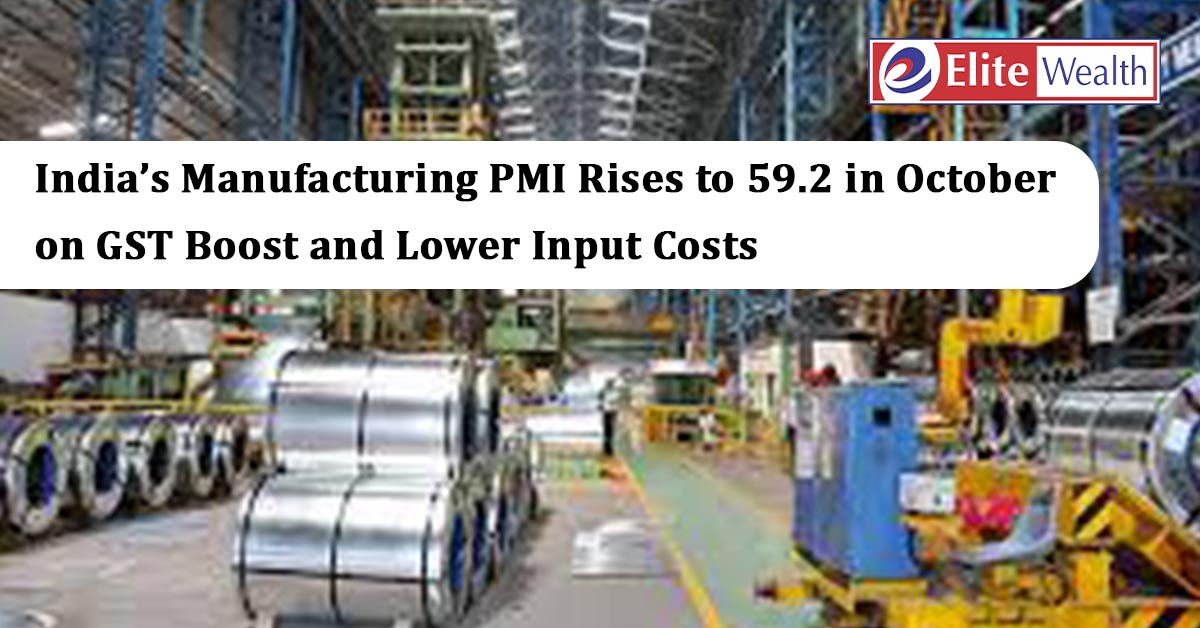
India’s manufacturing sector activity accelerated in October, with the Manufacturing Purchasing Managers’ Index (PMI) climbing to 59.2, up from 57.7 in September, according to data released by S&P Global. The rise signals a strong start to the third fiscal quarter, supported by robust domestic demand, GST-related relief measures, and softer input costs.
Strong Output and Demand Momentum
Pranjul Bhandari, Chief India Economist at HSBC, noted that the higher PMI reflected broad-based strength across the sector.
“Robust end-demand fuelled expansions in output, new orders, and job creation. Meanwhile, input prices moderated in October, while average selling prices increased as some manufacturers passed on cost burdens to consumers,” she said.
New orders grew sharply, driven by stronger domestic consumption, increased marketing activity, and GST reforms. The pace of expansion in output was among the strongest seen in the past five years, matching the growth rate recorded in August 2025.
Domestic Market Leads as Export Growth Slows
Most of the surge in sales came from the domestic market, while export orders rose at a slower pace. Although overseas demand for Indian goods continued to improve, October marked the weakest export growth of 2025 so far.
(Note: A PMI reading above 50 indicates expansion, while below 50 denotes contraction.)
Input Buying and Inventories Strengthen
Manufacturers stepped up purchases of raw materials and semi-finished goods to support higher production levels and build up inventories.
- Purchasing activity rose at the fastest pace since May 2023.
- Stock of inputs expanded at the second-fastest rate since March 2005, trailing only May 2023 levels.
Many firms cited strong demand as the primary reason for stockpiling, with some also fulfilling new orders from existing inventories.
Cost Pressures Easing, Output Prices Rising
Input cost inflation eased further in October, marking the weakest increase in eight months and remaining well below the long-run average. However, despite softer cost pressures, output prices rose at the joint-highest rate in 12 years, matching September’s level, as companies sought to maintain margins.
Employment and Outlook
Employment in the manufacturing sector increased for the 20th consecutive month, though the pace of hiring remained moderate and steady compared to September.
Manufacturers remained optimistic about future business conditions, with sentiment supported by:
- GST reforms improving compliance and efficiency,
- Capacity expansion plans, and
- Stronger marketing and sales efforts.
Overall, the data reflects sustained resilience in India’s manufacturing economy, driven by strong domestic fundamentals, easing cost pressures, and continued confidence in long-term demand.
Summary:
India’s Manufacturing PMI jumped to 59.2 in October, marking robust growth in factory output and domestic orders, aided by GST relief measures and lower input costs. While exports grew at a slower pace, manufacturers reported strong purchasing activity and rising optimism, signaling continued momentum in the sector’s expansion.
Disclaimer:
This article is intended solely for educational and informational purposes. The securities or companies mentioned are provided as examples and should not be considered as recommendations. Nothing contained herein constitutes personal financial advice or investment recommendations. Readers are advised to conduct their own research and consult a qualified financial advisor before making any investment decisions.
Investments in securities markets are subject to market risks. Please read all related documents carefully before investing
